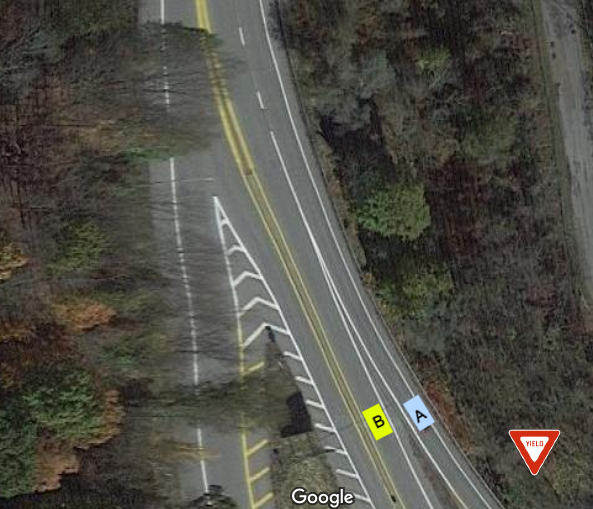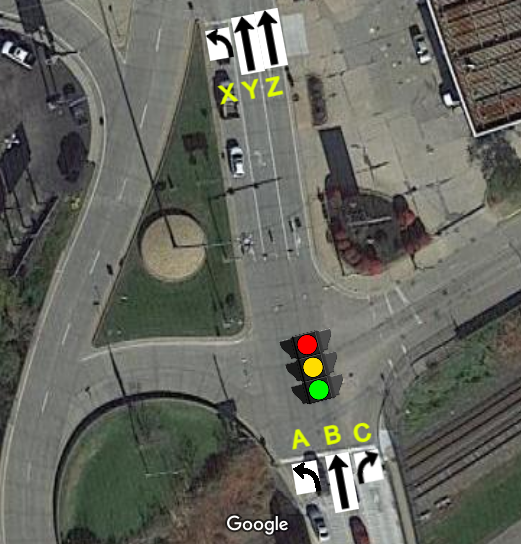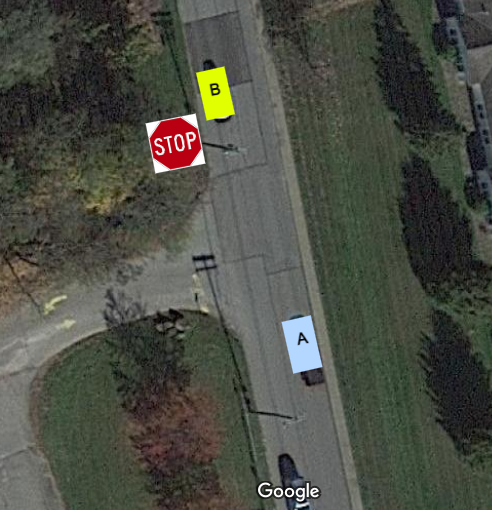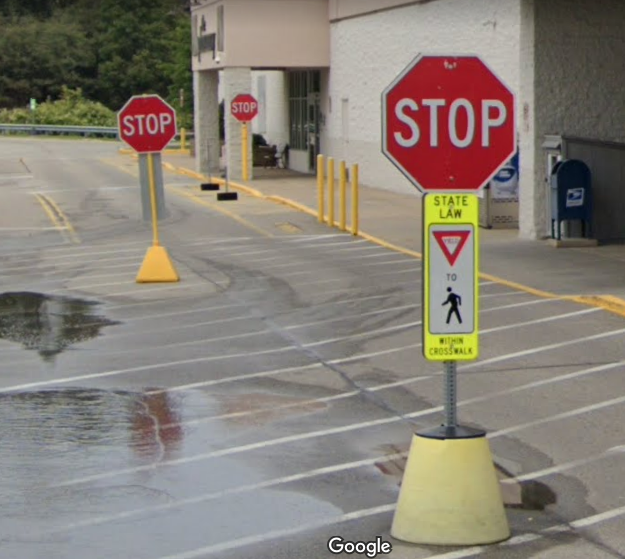These are all near where I live, and they bother me just a little bit every time I encounter them.
1. Who Should Yield? #1

Car A and B are traveling “up,” I guess is the direction. Car A’s onramp forms a new lane, but he has a yield sign. Why would Car A have to yield to Car B, if B wanted to move into his lane? B is the one crossing over, not A. It seems the yield sign is not really needed here.
2. Crossing Two Lanes

This is a shot of one end of a long bridge. A car in Lane B has to do two lane changes if the driver to turn left at Lane X, at the next light. The overhead photo is deceiving, because the distance is much shorter than what is depicted. The entire effect is worse when the traffic light at Lanes ABC is red, because folks going to Lane X will just sit in Lane A to go straight, ignoring the left-only designation. I’m surprised there haven’t been more accidents here from this setup. The easiest solution is to make Lane A be a left or straight direction lane. Likely, Lane A is left-only because it’s an on-ramp coming up from the streets below to the bridge, and the left-only is really a u-turn, heading to the opposite end of the bridge. I suppose TPTB predicted having a left and straight designation would back the traffic up.
3. Who Should Yield? #2

Car B has stopped and will go straight, while Car A, who doesn’t have a stop sign, is turning left. Who has the right of way? I defer to Car B because it had already made the stop and is going straight. No solution is great here, outside of adding a stop sign for Car A, or simply removing Car B’s stop sign. It’s not an exact science to determine when a car going the opposite way has “finished” stopping and has begun accelerating. Predictability, the cornerstone of safe traffic situations, is very low here.
4. Stop or Yield?

So, should you yield or stop here? If there’s a pedestrian, you let them cross; that much is obvious. When there’s no visible pedestrian is where the confusion comes in. The “stop” tells me to stop no matter what, while the “yield” says it’s okay to keep going. Visually, the stop sign gets top billing because it’s, uh, at the top and the first in reading order, and is bigger, and the yield sign is more of a message than an actual sign. To make matters worse, you can see farther down that there’s an actual stop sign and stop line, and there’s another straight stop sign behind you in this shot. No ambiguity there. And you can see the back of another stop-yield sign, facing the opposite direction. That’s four potential stops in the span of, what, a few hundred feet? That seems excessive. Most folks, including myself, follow the yield on these signs and don’t categorically stop when there’s no pedestrians around.
2 Comments
This is something I know about. 1. Discretionary choice made by local traffic engineers. It allows B to have priority over A for reasons we may never know, but certainly includes traffic data from the previous half-mile or so in both directions. 2. The real problem is not that lane B has three choices after the light turns, but all the other lanes running through the scene. It looks to me like the traffic engineers inherited a no-win situation. If A goes straight, they should get a ticket every time, but I’m willing to bet enforcement is very poor. 3. Without seeing a larger picture, I’d say A lanes probably never get a reasonable chance to turn left unless B has a stop sign. 4. No traffic engineers were involved in this; it’s private property and business managers generally suck at traffic engineering. Almost no parking lots were laid out by traffic experts except some few government agency parking lots.
#2 Yes, there’s no enforcement for lane A cars going straight. Tons of people do it because that intersection is always busy, even around 5 in the morning when I am heading to the gym. It’s a local custom, you could say, to ignore the left-only nature.
#4 “No traffic engineers were involved in this;” I suspected this is the case!
1 Trackback or Pingback